History
While it was part of the Byzantine empire, Ugento had Greek bishops and was subject to the Patriarch of Constantinople. Ugento was destroyed by the Saracens in the 8th century, and by the Turks in 1527. [3] The earliest recorded bishop, Joannes, is known from a Greek liturgical text, and he may have been a Greek bishop. The Greek rite flourished in many places in the diocese of Ugento until 1591.
Of the Latin bishops, the earliest known is the Benedictine monk of Montecassino, Symon, of unknown date. [4]
The Latin diocese used to be a suffragan of the archdiocese of Otranto, until 1980. [5]
In 1818, a new concordat with the Kingdom of the Two Sicilies committed the pope to the suppression of more than fifty small dioceses in the kingdom. In the ecclesiastical province of Otranto, the diocese of Alessano, [6] formerly a suffragan of Otranto, was suppressed by Pope Pius VII in the bull "De Utiliori" of 27 June 1818, and its territory incorporated into the diocese of Ugento. [7] In the same concordat, the King acquired the right to nominate candidates for vacant bishoprics. That situation persisted down until the final overthrow of the Bourbon monarchy in 1860. [8]
In 1959, Bishop Giuseppe Ruotolo (1937–1968) petitioned the Vatican for permission to add the name of the local manifestation of the Virgin Mary, S. Maria de Leuca, to the name of the diocese. His stated reasons were: to strengthen the traditional devotion of his people to the Virgin; to obtain favors from the Virgin; and to strengthen the bonds that connected his people with the Papacy. Pope John XXIII approved the petition, and on 1 August 1959 the Sacred Consistorial Congregation authorized the change, and delegated to Bishop Ruotolo all the necessary and appropriate powers to bring the change into effect. He was required to supply the Congregation with an authentic copy of the act which brought about the change. The change brought no alteration in the constitution, administration, or operation of the diocese. [9]
Following the Second Vatican Council, and in accordance with the norms laid out in the Council's decree, Christus Dominus chapter 40, [10] the Episcopal Conference of Apulia petitioned the Holy See (Pope) that Lecce be made a metropolitan and that a new ecclesiastical province be created. After wide consultations among all affected parties, Pope John Paul II issued a decree on 20 October 1980, elevating Lecce to the status of metropolitan see. He also created the new ecclesiastical province of Lecce, whose constituent bishoprics (suffragans) were to be: Brindisi (no longer a metropolitanate, though the archbishop allowed to retain the title of archbishop), Otranto (no longer a metropolitanate, though the archbishop allowed to retain the title of archbishop), Gallipoli, Nardò, Ostuno, and Uxentina-S. Mariae Leucadensis (Ugento). [11]
Pope Francis visited the Diocese on Friday 20 April 2018. [12]
Cathedral and Chapter
The cathedral of Ugento was originally dedicated in honor of S. Vincent of Saragossa. When a new cathedral was built, in 1745 it was dedicated to the taking up (assumption) of the body of the Virgin Mary into heaven.
The cathedral was administered by a Chapter. The Cantor and Chapter are mentioned in the letter of Pope Martin IV on 23 November 1282, in which he approves their request to have Bishop Goffredus of Leuca transferred to Ugento as their bishop in succession to the late Bishop Lando. [13] In 1705, there were three dignities and twelve Canons in the Chapter. [14] In the mid-nineteenth century, the Chapter consisted of only one dignity, the Cantor, and ten Canons. [3]
Synods
A diocesan synod was an irregularly held, but important, meeting of the bishop of a diocese and his clergy. Its purpose was (1) to proclaim generally the various decrees already issued by the bishop; (2) to discuss and ratify measures on which the bishop chose to consult with his clergy; (3) to publish statutes and decrees of the diocesan synod, of the provincial synod, and of the Holy See. [15]
Bishop Ludovico Ximenes (Jiménez) (1627–1636) held a diocesan synod on 26 November 1628. [16] On 3 August 1645, Bishop Girolamo Martini (1637–1648) presided over a diocesan synod. [17] Bishop Antonio Carafa (1663–1704) held a diocesan synod on 27 October 1680, his second synod. [18] The Vicar Capitular, Giuseppe Felice Salzedo, held a synod in the cathedral on 20 May 1720. [19]

The Archdiocese of Otranto is a Latin archdiocese of the Catholic Church in Italy. The seat of the diocese is at Otranto Cathedral in the city of Otranto, Apulia. It is a suffragan of the archdiocese of Lecce.

The Diocese of Nardò-Gallipoli is a Latin diocese of the Catholic Church in southern Italy. It is a suffragan of the Archdiocese of Lecce.
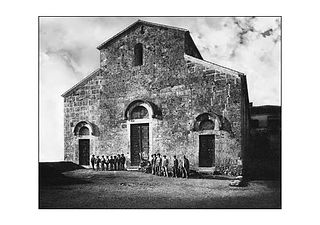
The Roman Catholic diocese of Ferentino existed until 1986, when it was united into the new diocese of Frosinone-Veroli-Ferentino.

The Diocese of Nocera Umbra was a Catholic diocese in Umbria, Italy.

The Diocese of Avellino is a Latin diocese of the Catholic Church in the territory of the Irpini, some 55 km (30 mi) east of Naples and 23 km (14 mi) south of Benevento, in the modern Republic of Italy. It is suffragan to the archdiocese of Benevento. The bishop of Avellino, along with the bishop of S. Agata de' Goti, had the privilege, recognized at the provincial synod of 1654, of being summoned to attend upon the death and obsequies of the archbishop of Benevento.

The Archdiocese of Lecce is a Latin Church ecclesiastical territory or archdiocese of the Catholic Church in Apulia, southern Italy. The diocese has existed since the 11th century. On 28 September 1960, in the bull Cum a nobis, Pope John XXIII separated the diocese of Lecce from the ecclesiastical province of Otranto and made it directly subject to the Holy See. In the bull Conferentia Episcopalis Apuliae issued on 20 October 1980, Pope John Paul II created the ecclesiastical province of Lecce, with the Archdiocese of Otranto becoming a suffragan diocese.

The Diocese of Orvieto-Todi is a Latin Church ecclesiastical territory or diocese of the Catholic Church in central Italy. It was created in 1986 when the historical Diocese of Orvieto was united to the Diocese of Todi. The Diocese of Orvieto-Todi is immediately exempt to the Holy See and not part of any ecclesiastical province.
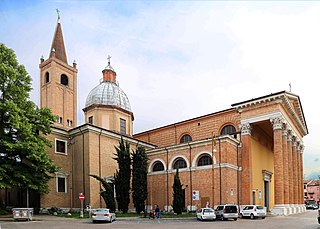
The Diocese of Forlì-Bertinoro is a Latin diocese of the Catholic Church in Romagna, Italy. Until 1986 it was known as the Diocese of Forlì, in existence perhaps from the fourth century. In that year the Diocese of Bertinoro was united to it. The diocese is suffragan to the Archdiocese of Ravenna-Cervia.

The Archdiocese of Crotone-Santa Severina is a Latin Church diocese of the Catholic Church in Calabria in southern Italy, created in 1986 when it was combined with the Diocese of Santa Severina. It is now a suffragan of the Archdiocese of Catanzaro-Squillace. In 2013 there was one priest for every 1,841 Catholics.

The diocese of Teano-Calvi is a Latin diocese of the Catholic Church in Campania, southern Italy, created in 1986. It is a suffragan of the Archdiocese of Naples. The historic Diocese of Teano and diocese of Calvi Risorta were united in 1818, forming the diocese of Calvi e Teano.

The Diocese of San Severo is a Latin diocese of the Catholic Church in Apulia. It is a suffragan of the Archdiocese of Foggia-Bovino.
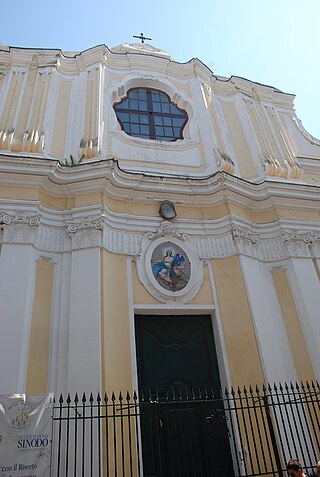
The Diocese of Ischia is a Latin diocese of the Catholic Church in Campania, southern Italy. It is a suffragan of the Archdiocese of Naples. The diocese comprises the entire island of Ischia, which contains seven communes divided into two circumscriptions. In 1743, the population was about 4,000. The city of Ischia constituted one single parish, with two religious houses of men and one of women. In 2018, the population of the town of Ischia was 20,118.

The Diocese of Pozzuoli is a Latin diocese of the Catholic Church in Campania, southern Italy. It is a suffragan of the Metropolitan Roman Catholic Archdiocese of Naples, like its other neighboring dioceses, Aversa and Ischia.

The Diocese of Fossano is a Latin diocese of the Catholic Church in Piedmont, in the Province of Cuneo. It is a suffragan of the Archdiocese of Turin.
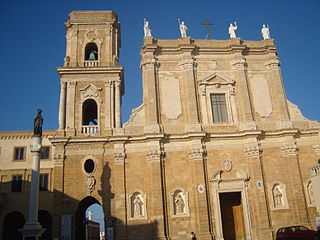
The Archdiocese of Brindisi-Ostium is a Latin diocese of the Catholic Church in Apulia, has carried its present name since 1986. It is a suffragan of the archdiocese of Lecce.

The Diocese of Sessa Aurunca is a Latin diocese of the Catholic Church in southern Italy. Since 1979 it has been a suffragan of the Archdiocese of Naples.

The Diocese of Anagni-Alatri is a Latin Church ecclesiastical territory or diocese of the Catholic Church in Lazio, Italy. It has existed in its current form since 1986. In that year the Diocese of Alatri was united to the historical Diocese of Anagni. The diocese is immediately exempt to the Holy See.
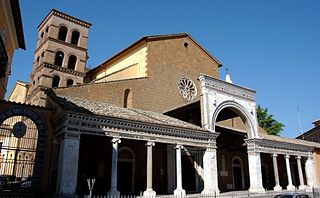
The Diocese of Civita Castellana is a Latin Church ecclesiastical territory or diocese of the Catholic Church in Latium, central Italy. It has existed in the current form since 1986, when the Diocese of Nepi e Sutri was united into the Diocese of Civita Castellana, Orte e Gallese. The Diocese of Gallese had been added to the Dioceses of Civita Castellana and Orte in 1805. The name of the diocese was shortened in 1991, in accordance with Vatican policies. The diocese of Civita Castellana is immediately exempt to the Holy See.
The Italian Catholic diocese of Lacedonia, a suffragan of the archdiocese of Benevento in Campania, existed until 1986 when incorporated into the reorganized Roman Catholic Diocese of Ariano Irpino-Lacedonia.
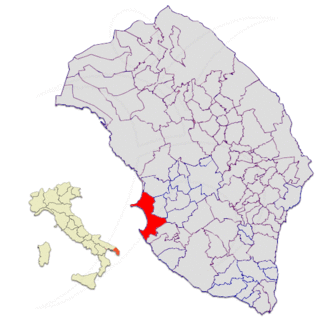
The Diocese of Gallipoli was a Roman Catholic ecclesiastical territory in the province of Apulia in southern Italy. It was erected in the 6th century. On September 30, 1986, the diocese was suppressed, and its territory merged into the Diocese of Nardò-Gallipoli.



















